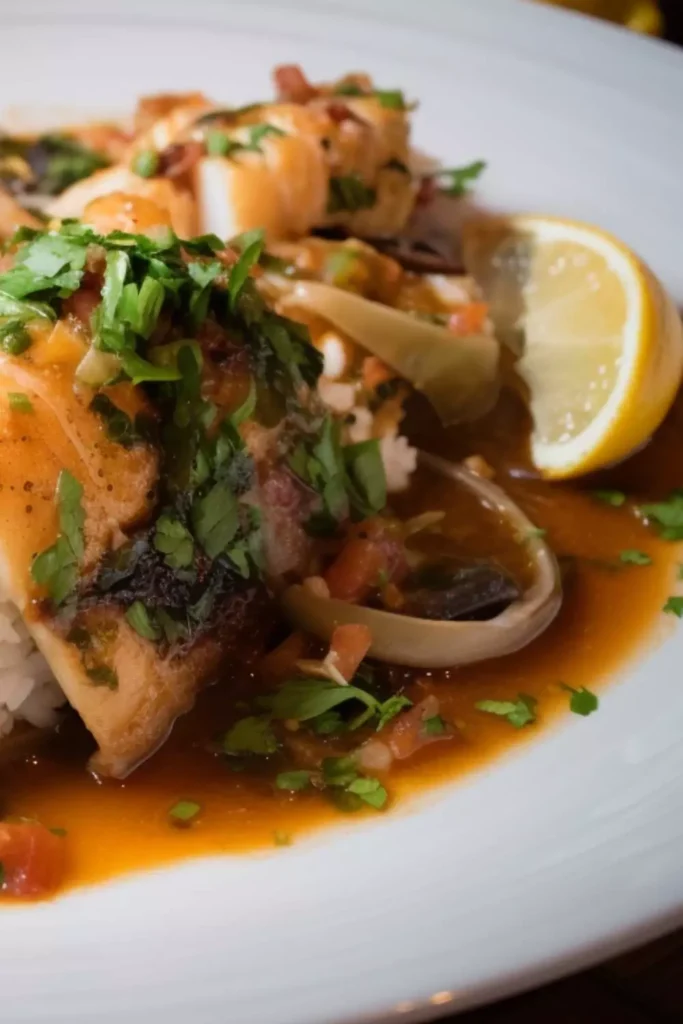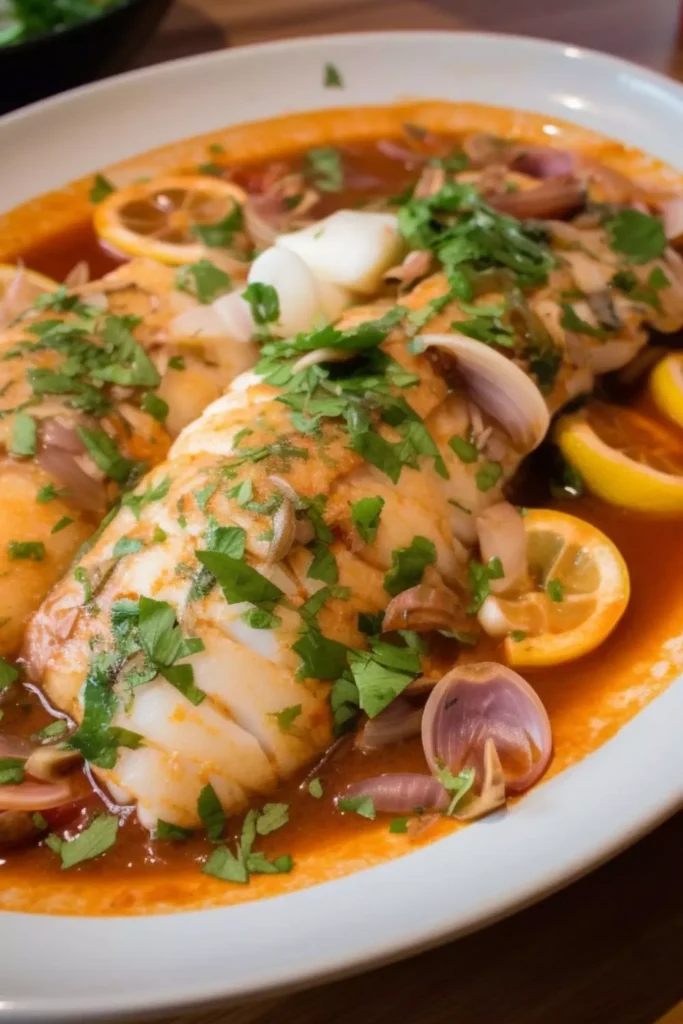As an avid food lover and culinary enthusiast, I always find myself gravitating towards trying new and exciting recipes that transport me to different parts of the world through their flavors.
One such dish that has captured my taste buds and left me craving for more is the exquisite Peruvian delicacy called “pescado a lo macho.”
This seafood extravaganza is a celebration of vibrant colors, bold spices, and a harmonious blend of fresh ingredients that come together to create a symphony of flavors on your palate.
Before delving into the detailed steps of preparing this tantalizing dish, let’s take a closer look at the star ingredients that form the backbone of pescado a lo macho.

Ingredients
1. Fish Fillets: The key component of this dish is the fish fillets, typically made with white fish such as tilapia or sole. The delicate and flaky texture of the fish pairs beautifully with the rich and creamy sauce that envelops it, creating a truly decadent dining experience.
2. Vegetable Oil: Used for sautéing the aromatics and creating the base of the sauce, vegetable oil adds a subtle richness to the dish without overpowering the other flavors.
3. Aromatics: A medley of red onion, garlic, basil, and parsley infuses the dish with aromatic notes that provide depth and complexity to the overall flavor profile.
4. Bell Peppers: The vibrant colors of red and yellow bell peppers not only add visual appeal to the dish but also contribute a sweet and tangy flavor that balances out the heat from the chilies.
5. Aji Amarillo Paste: This Peruvian yellow chili paste is the star ingredient that brings a fiery kick to the dish, elevating it to a whole new level of spiciness and intensity.
6. Aji Rocoto Sauce: Another essential element in Peruvian cuisine, Aji Rocoto sauce lends a distinct flavor and heat to the dish, creating a perfect harmony of flavors.
7. Diced Tomatoes: The acidity and sweetness of diced tomatoes help to balance the richness of the sauce, while also adding a pop of color and freshness to the dish.
8. Fish or Seafood Stock: Enhancing the seafood essence of the dish, fish or seafood stock infuses a depth of flavor that ties all the components together harmoniously.
9. Heavy Cream: Adding a luscious creaminess to the sauce, heavy cream enriches the dish and creates a velvety texture that coats the fish fillets luxuriously.
10. White Wine (Optional): For those who enjoy a touch of acidity and complexity in their dishes, white wine can be used to deglaze the pan and add a subtle depth of flavor to the sauce.
11. Seasonings: Salt and pepper are essential to bring out the flavors of the other ingredients and ensure a well-balanced and seasoned final dish.
12. Cilantro: Fresh cilantro, chopped and used as a garnish, adds a burst of freshness and herbaceousness that brightens up the entire dish.

How to Make Pescado a lo Macho?
Step 1: Prepare and Season the Fish Fillets
Start by patting the fish fillets dry with a paper towel. This helps in achieving a crispy texture. Season both sides of the fillets generously with salt and pepper. Set them aside.
Step 2: Sear the Fish Fillets
Heat a large skillet over medium-high heat and add two tablespoons of vegetable oil. Once the oil is hot, carefully place the seasoned fish fillets in the skillet. Sear each side for about 3-4 minutes or until they develop a golden-brown crust. Once done, remove the fillets from the skillet and set them aside.
Step 3: Sauté the Aromatic Vegetables
In the same skillet, add more oil if needed. Toss in the finely chopped red onion, minced garlic, red and yellow bell peppers. Sauté the vegetables until they become tender and release their flavors.
Step 4: Add Herbs for Freshness
Introduce a handful of basil leaves and parsley to the sautéed vegetables. These herbs add a burst of freshness to the dish. Stir them into the mix for a delightful aroma.
Step 5: Infuse with Peruvian Flavors
Incorporate the Peruvian flavors by adding 1/4 cup of aji amarillo paste, providing a unique and spicy kick to the dish. Adjust the heat level according to your preference by adding aji rocoto sauce.
Step 6: Develop the Tomato Base
Add a can of diced tomatoes (14 oz) to the skillet. Allow the mixture to cook for approximately 5 minutes, allowing the tomatoes to break down and the sauce to thicken.
Step 7: Enhance with White Wine (Optional) and Stock
Pour in 1/4 cup of white wine if you choose to use it. Allow it to reduce for a few minutes to intensify the flavors. Following that, add 1/2 cup of fish or seafood stock, letting the mixture simmer for around 10 minutes to meld the flavors.
Step 8: Creamy Finish
Stir in 1/2 cup of heavy cream, providing a luscious and creamy texture to the sauce. Allow it to simmer and thicken slightly.
Step 9: Reunite Fish with the Sauce
Carefully return the seared fish fillets to the skillet, allowing them to simmer in the flavorful sauce for a couple of minutes. This step ensures the fish absorbs the rich flavors of the sauce.
Step 10: Garnish and Serve
Garnish the Pescado a lo Macho with a generous amount of freshly chopped cilantro. Serve the dish hot, accompanied by your choice of rice or potatoes.

Nutrition Information
Pescado a lo macho is a nutritious and healthy dish. It is a great source of protein, vitamins, and minerals. One serving of the dish (about 1 cup) provides approximately:
– Calories: 300
– Protein: 25g
– Fat: 8g
– Carbohydrates: 20g
– Fiber: 3g
– Vitamin A: 20% of the daily value
– Vitamin C: 8% of the daily value
– Iron: 10% of the daily value
Recipe Notes:
– Aji Amarillo Paste: Known for its vibrant color and fiery heat, aji amarillo paste is a staple in Peruvian cuisine and adds a distinctive spiciness to dishes.
– Aji Rocoto Sauce: Made from rocoto peppers, Aji Rocoto sauce is a bold and flavorful condiment that packs a punch of heat and intensity.
Recipe Variations:
– For a lighter version of the dish, you can use coconut milk instead of heavy cream to create a dairy-free alternative.
– Experiment with different types of fish such as mahi-mahi or snapper to vary the flavors and textures of the dish.
– Add a squeeze of fresh lime juice at the end to brighten up the flavors and add a citrusy zing to the dish.

Equipment
- shallow dish
- Skillet
- paper towels
Ingredients
- 4 fish fillets typically white fish like tilapia or sole
- 2 tablespoons of vegetable oil
- 2 cloves of garlic minced
- Couple basil leaves
- 1 red onion finely chopped
- Couple sprigs of parsley
- 1 red bell pepper finely chopped
- 1 yellow bell pepper finely chopped
- 1/4 cup of aji amarillo paste Peruvian yellow chili paste
- Aji Rocoto sauce
- 1 can of diced tomatoes 14 oz
- 1/2 cup of fish or seafood stock
- 1/2 cup of heavy cream
- 1/4 cup of white wine optional
- Salt and pepper to taste
- Chopped fresh cilantro for garnish
Instructions
- Start by patting the fish fillets dry with a paper towel. This helps in achieving a crispy texture. Season both sides of the fillets generously with salt and pepper. Set them aside.
- Heat a large skillet over medium-high heat and add two tablespoons of vegetable oil. Once the oil is hot, carefully place the seasoned fish fillets in the skillet. Sear each side for about 3-4 minutes or until they develop a golden-brown crust. Once done, remove the fillets from the skillet and set them aside.
- In the same skillet, add more oil if needed. Toss in the finely chopped red onion, minced garlic, red and yellow bell peppers. Sauté the vegetables until they become tender and release their flavors.
- Introduce a handful of basil leaves and parsley to the sautéed vegetables. These herbs add a burst of freshness to the dish. Stir them into the mix for a delightful aroma.
- Incorporate the Peruvian flavors by adding 1/4 cup of aji amarillo paste, providing a unique and spicy kick to the dish. Adjust the heat level according to your preference by adding aji rocoto sauce.
- Add a can of diced tomatoes (14 oz) to the skillet. Allow the mixture to cook for approximately 5 minutes, allowing the tomatoes to break down and the sauce to thicken.
- Pour in 1/4 cup of white wine if you choose to use it. Allow it to reduce for a few minutes to intensify the flavors. Following that, add 1/2 cup of fish or seafood stock, letting the mixture simmer for around 10 minutes to meld the flavors.
- Stir in 1/2 cup of heavy cream, providing a luscious and creamy texture to the sauce. Allow it to simmer and thicken slightly.
- Carefully return the seared fish fillets to the skillet, allowing them to simmer in the flavorful sauce for a couple of minutes. This step ensures the fish absorbs the rich flavors of the sauce.
- Garnish the Pescado a lo Macho with a generous amount of freshly chopped cilantro. Serve the dish hot, accompanied by your choice of rice or potatoes.
Notes
- Aji Amarillo Paste: Known for its vibrant color and fiery heat, aji amarillo paste is a staple in Peruvian cuisine and adds a distinctive spiciness to dishes.
- Aji Rocoto Sauce: Made from rocoto peppers, Aji Rocoto sauce is a bold and flavorful condiment that packs a punch of heat and intensity.
Nutrition
FAQs:
1. Can I make pescado a lo macho ahead of time?
Yes, you can prepare the sauce in advance and store it in the refrigerator for up to 2 days. When ready to serve, simply reheat the sauce and add the seared fish fillets to warm through.
2. Is it essential to use Peruvian ingredients for authenticity?
While using traditional Peruvian ingredients enhances the authenticity and flavor profile of the dish, you can always substitute with locally available alternatives without compromising on taste.
3. Can I make pescado a lo macho with different types of seafood?
Absolutely! This versatile dish can be adapted to include a variety of seafood such as shrimp, scallops, or even a combination of different types of fish for a seafood medley.
4. How spicy is pescado a lo macho?
The heat level of the dish can be adjusted based on your preference by varying the amount of aji amarillo paste and Aji Rocoto sauce used in the recipe.
5. What side dishes pair well with pescado a lo macho?
Traditional accompaniments such as steamed white rice, quinoa, or Peruvian-style potatoes make excellent side dishes to complement the rich and flavorful nature of the dish.
6. Can I freeze pescado a lo macho for later consumption?
While the sauce can be frozen for up to 3 months, it is recommended to prepare the fish fillets fresh when ready to serve to maintain their texture and flavor.
Conclusion:
Pescado a lo macho is a culinary masterpiece that encapsulates the vibrant and diverse flavors of Peruvian cuisine in every bite.
From the fiery kick of aji amarillo paste to the creamy richness of the sauce, this dish is a sensory delight that promises a culinary journey like no other.
Whether you are a seafood enthusiast or simply looking to explore new flavors, pescado a lo macho is a must-try recipe that will tantalize your taste buds and leave you craving for more.
So gather your ingredients, fire up your skillet, and embark on a gastronomic adventure to savor the exquisite flavors of Peru right in your own kitchen.
With its captivating blend of savory spices, succulent seafood, and creamy sauces, pescado a lo macho offers a decadent dining experience that is sure to impress even the most discerning palates.
So why wait? Dive into the world of Peruvian cuisine and elevate your culinary repertoire with this unforgettable dish that celebrates the richness and diversity of flavors that make the gastronomy of Peru truly exceptional. Cheers to good food, great company, and unforgettable culinary experiences!
You’ll also like these latest recipes!

Rebecca Novak is a trained chef with over 10 years of experience in the food industry. She has worked in both fine dining and casual Hungarian restaurants and specializes in creating dishes using fresh, seasonal ingredients. She also loves exploring different cuisines worldwide, which allows her to bring unique flavors and ideas to the recipes she creates for Hungarianchef.com. Read more
